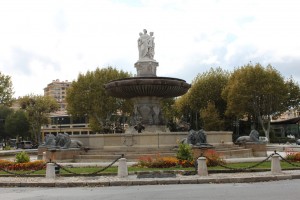
Disillusioned! Since the age of fourteen I had wanted to visit Aix-en-Provence. My boyfriend, or so he fancied himself, had moved to Aix for twelve months with his family. Upon their return, I still wanted nothing to do with him, but I was seriously interested in the exotic sounding city, in the south of France. Fast-forward some 30 years, my husband and I were living in Aix en Provence with our black Labrador, for six months – I was not immediately enthralled with the city. Was I crazy?
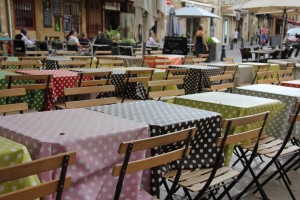
Aix-en-Provence, the former capital of Provence, is a large city for the region, with a population of over 140,000. Geographically butted up against the port city of Marseille. The citizens of Aix have historically maintained that their city breeds intellects as evidenced by the school of law, the court of appeals and the university founded in 1409.
First named Aquae Sextiae, the waters of Sextius Calvinus, who was the revered consul of the Roman Republic in 124BC. Aix has always been graced with easy access to water. The settlement was prosperous; it continued to evolve as a sophisticated centre and home of the once dominant counts of Provence. The sunny location attracted and inspired the artistic talents of famous painters like Paul Cézanne and Pablo Picasso, writers such as Émile Zola and Ernest Hemmingway.
Slowly, each day passed with a pleasant rhythm then suddenly I realized that Aix had worked her charm. The city now had one more fan to add to the list of those who have come to visit, and may never willingly leave.
The “City of Water and City of Art” has so much to offer a visitor it is difficult to create a shortlist. Once you are hooked, create your own Top-10 list of things to do in Aix-en-Provence, here is mine (in no particular order).
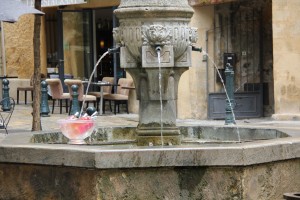
- The Fountains of Aix are iconic reminders of how vital water was to this city. At one time, these water sources were purely functional fulfilling domestic requirements. Once running water was available in private residences, the remaining fountains were embellished with artistic elements. My personal favourite is Place des Trois Ormeaux. Which one is yours?
- The cloisters inside Cathédrale St-Sauveur. The church itself is intriguing due to a construction period ranging from the 5C to 17C, the famous triptych of the Burning Bush and the baptistery. However, the Romanesque cloisters are the jewels.
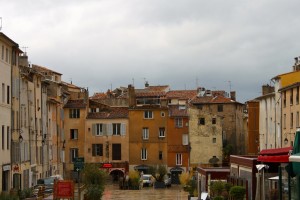
- Place des Cardeurs, a large open square surrounded by residences and restaurants. This forum used to be the Jewish quarter of Aix and the place where sheep were sheared using the carde (a prickly comb-like plant). The transformation of a slum and urban eye-soar began in 1963. Today, one could be forgiven by thinking that they had entered an Italian piazza. Choose any restaurant terrace and enjoy a drink or a meal.
- Markets happen every day of the week in Aix. This is a true paradise for food and bargain lovers. My favourite market is at Place Richeleme – explore and find your own. What attracts you to a market?
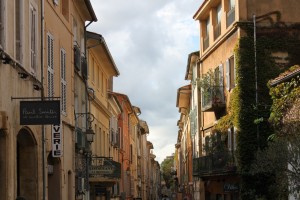
- Quartier Marzarin conceived and built between 1646-51. The area was designed on a grid pattern, at the time quite a modern concept and poles apart from the winding lanes of the old town. The Quartier Mazarin remains a chic address, filled with cute stores and cozy restaurants.
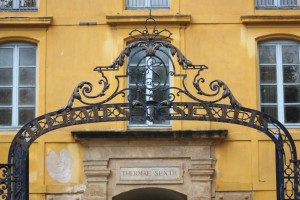
- Thermes Sexitus is today a luxurious spa, built on the site of previous Roman baths. You can still see the foundations of the ancient construction.
- Cours Mirabeau has been compared to the Champs-Elysées in Paris. Personally I find little resemblance. Shaded by towering plane trees, the restaurant terraces are filled from the early hours until late into the evening. Have a drink at Café des Deux Garçons and imagine Cézanne and Zola discussing their studies.
- Cité du Livre a dream location for bookworms and those who appreciate contemporary architecture. A modern glass structure was constructed to accommodate some 80,000 volumes that were donated to the city by Marquis de Méjanes. The city’s ballet troupe is based out of the same location adjacent to a modern 1300 seat auditorium.
- Rue d’Italie runs along the edge of the Mazarin district. Interesting shops, tempting food stores and tiny restaurants, line this charming street. Very recently it was converted to pedestrian friendly, so take a stroll.
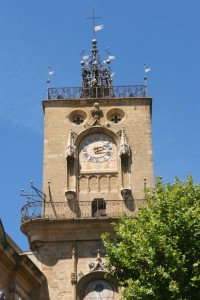
- Tour de l’Horloge the clock tower sits on Roman foundations. It is located on the edge of Place des Cardeurs and the Hôtel de Ville dates from 1510. The belfry was once a symbol of the prosperity of Provence. The astronomical clock was added in 1661.
Here, is a list of quick resources for your own Aix tour:
- Michelin – The Green Guide Provence
- Rick Steves’ Provence & The French Riviera guidebook
- Self-Guided Audio Tour App – Mobile App – Edible Heritage – http://www.edibleheritage.com
- Yes you can get buy with out French, the city caters to tourists. The public Transport system is great, a few free options too.
- If you have kids, it is definitely a city more oriented to university, high school age and older folks.
Have you been to France? Is it a place on your list to visit?
Photos courtesy of Carolyne Kauser-Abbott
About the author
Carolyne Kauser-Abbott has background in the investment business and commercial real estate. An opportunity for change allowed her to start writing and launching travel Apps. Like many things in life, it is the unexpected. She has always been a traveler. Her motivation for writing comes from a genuine curiosity, and desire to learn. Some friends encouraged her to start documenting her passions around food, travel and fun discoveries.
Fast forward a few years and now you can follow her on her blog Ginger and Nutmeg http://www.gingerandnutmeg.com, Find her on Facebook at https://www.facebook.com/pages/Ginger-and-Nutmeg/ 134370783251300 Follow along on Twitter @gingerandnutmegFind her Pinterest boards at http://pinterest.com/gingerandnutmeg/ And Check out her mobile app @ http://www.edibleheritage.com






 Sneak Peek at Sugar Factory’s Valentine’s
Sneak Peek at Sugar Factory’s Valentine’s
Leave a Reply